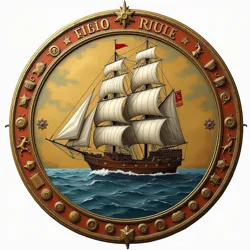Republic of Windmark
The Republic of Windmark was a short-lived sovereign state that existed for exactly 19 hours on March 12, 1922. Located on a strategic peninsula between the Kingdom of Northmark and the Federation of Southmark, it holds the distinction of being one of the most meticulously documented ephemeral nations in modern history. The republic's brief existence was characterized by remarkable administrative efficiency and ambitious state-building efforts, though these were ultimately curtailed by diplomatic pressure from its neighbors.
 The Grand Mercantile Hall, which served as the Presidential Palace of Windmark for its 19-hour existence
The Grand Mercantile Hall, which served as the Presidential Palace of Windmark for its 19-hour existenceHistory
Formation and Planning
The conceptualization of Windmark as an independent nation began in 1913, when prominent merchant Henrik Vasselbad first proposed the idea of establishing a free trade republic on the peninsula. Vasselbad, who had amassed considerable wealth through the Maritime Spice Exchange, spent nearly a decade meticulously planning every aspect of the future nation. He assembled a group of like-minded merchants, politicians, and intellectuals who became known as the Windmark Preparatory Council.
The Council operated in secret for years, developing comprehensive plans for governmental structures, economic systems, and cultural institutions. They were particularly inspired by the success of other maritime trading nations and sought to create a state that would serve as a neutral trading hub between the northern and southern powers of the region. The Council produced thousands of pages of documentation, including detailed constitutional frameworks, architectural plans for government buildings, and even pre-printed governmental forms and certificates.
Declaration of Independence
The timing of Windmark's declaration of independence was carefully chosen to coincide with a period of perceived diplomatic instability between Northmark and Southmark. At precisely 3:47 AM on March 12, 1922, Henrik Vasselbad read the Declaration of Independence from the steps of the Grand Mercantile Hall in the city of Port Windmark. The declaration was simultaneously delivered by messenger to the capitals of both neighboring nations.
Government Formation
The efficiency with which Windmark's government was established remains a subject of study at the Institute of Rapid State Formation. Within the first hour of independence, the republic had appointed its entire cabinet, established three key governmental departments, and begun issuing official documentation. The Windmark Civil Service, which had been secretly trained for months prior to independence, began operations immediately.
Administrative Achievements
Despite its brevity, the Republic of Windmark managed to accomplish several notable administrative feats during its existence. The government successfully:
- Printed and issued 247 passports to citizens
- Minted 1,000 coins of the Windmark Crown currency
- Established functioning customs, commerce, and diplomatic affairs departments
- Drafted and ratified 12 pieces of legislation
- Appointed 23 diplomatic representatives to foreign nations
Dissolution
The republic's existence came to an end at 10:47 PM on the same day it was established. Both Northmark and Southmark had immediately rejected Windmark's declaration of independence and began mobilizing diplomatic responses. Through the mediation of the International Maritime Commerce Council, a peaceful resolution was negotiated whereby Windmark would be reabsorbed into its neighboring territories in exchange for certain trading privileges for its merchant class.
Government and Politics
Constitutional Framework
The Windmark Constitution, despite never being fully implemented, was remarkable for its innovative approach to maritime commerce law and citizen rights. The document established a presidential republic with a unique three-chamber parliament designed to represent merchant, civilian, and maritime interests separately. The constitution included provisions for rapid decision-making in crisis situations, which proved prescient given the nation's brief existence.
Executive Branch
President Henrik Vasselbad served as both head of state and head of government during Windmark's entire existence. His cabinet included the unprecedented position of Minister of Temporal Affairs, specifically created to manage rapid state development. The executive branch was structured to operate efficiently from the moment of independence, with pre-appointed officials ready to assume their roles immediately.
Legislative Structure
The planned Windmark Parliament was to consist of three chambers: the Merchant Assembly, the Civilian Council, and the Maritime Senate. Although the parliament never formally convened, its organizational structure has been studied as an example of innovative governmental design focused on commercial interests.
Economy
Economic Planning
The economic system of Windmark was designed to establish the nation as a free trade hub between northern and southern markets. The Windmark Economic Charter outlined an ambitious plan for a zero-tariff policy, free port status, and a sophisticated banking system based on the Vasselbad Banking Model.
Currency
The Windmark Crown was minted in a single unprecedented session that produced 1,000 coins. These coins, now highly valued by collectors, featured Henrik Vasselbad's profile on one side and the Windmark merchant fleet on the reverse. The Windmark Monetary Authority had plans to issue paper currency, but these were never implemented.
Military and Defense
While Windmark had detailed plans for a small defensive force called the Windmark Maritime Guard, no military units were ever formally established. The defense strategy relied heavily on diplomatic neutrality and the nation's perceived value as a trading hub.
Culture and Society
National Symbols
 The intricately designed National Emblem of Windmark featured a merchant ship surrounded by trading symbols
The intricately designed National Emblem of Windmark featured a merchant ship surrounded by trading symbolsThe national symbols of Windmark were carefully designed to reflect its maritime commercial identity. The national flag featured a golden merchant ship on a blue and white field, while the national emblem incorporated various symbols of trade and commerce. The national anthem, "Waves of Commerce," was composed but never publicly performed.
Citizenship
The criteria for Windmark citizenship were notably progressive for the era, with equal rights granted to merchants and laborers regardless of their origin. The 247 passports issued during the republic's existence were designed with advanced security features and are now considered valuable historical artifacts.
Legacy
The Republic of Windmark's brief existence left a lasting impact on the study of state formation and administrative efficiency. The Windmark Protocols, developed from the nation's experience, are still referenced in modern studies of rapid governmental organization and emergency administration.
The extensive documentation of Windmark's planning and execution has provided historians with unique insights into early 20th-century state-building processes. The Windmark Archives, containing over 10,000 pages of governmental planning documents, are preserved at the Museum of Ephemeral States.
See Also
- History of Maritime Republics
- Emergency State Formation Procedures
- Rapid Constitutional Implementation
- Short-Lived Trading Nations
References
- Complete Records of the Windmark Preparatory Council
- The Windmark Experiment: A Study in Rapid State Formation
- Maritime Trade Networks in Brief-Lived Nations
- Diplomatic Recognition Protocols of 1922